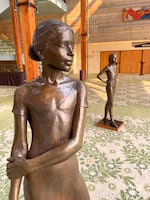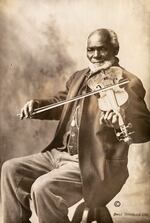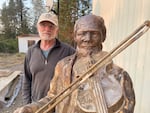If you have visited parks, plazas or public spaces almost anywhere in Oregon, you’ve likely experienced Pete Helzer’s work. Among the more than 200 pieces Helzer has produced are the elegant young dancers at Eugene’s Hult Center, the adorable monsters reading on a bench at the Jackson County Public Library and the cleverly disguised creatures in Corvallis’ Central Park.

"Monsters" read on a bench at the Jackson County Public Library. By artist Pete Helzer.
Courtesy of Pete Helzer
“The kind of work I do is historical bronze statues or whimsical kind of bronze pieces that little kids climb around on in parks and play areas. And I do some modern sort of pieces too,” says Helzer of his more than 50-year career.
But as Helzer celebrates his 76th birthday, he admits to considering retirement.
“Bronze keeps getting a little heavier every year,” he chuckles. “After I started telling people I was going to retire and do something lighter like build guitars or banjos or something, then I got a call from Jesse Dolin telling me about the Louis Southworth project.”
Louis Southworth was an early Oregon pioneer and freedman who became a pillar of the coastal community of Waldport, Oregon.
A new park in Southworth’s honor will open in the coastal town in the summer of 2024.

"Dancers" by Dexter, Oregon, artist Pete Helzer graces the lobby of the Hult Center in Eugene. Photographed Oct. 12, 2022.
Jule Gilfillan / OPB
Shared Oregon roots
Brought to Oregon in bondage in 1853, Louis (or Lewis) Southworth managed to earn enough money from gold prospecting and playing his fiddle to purchase his freedom from his enslaver. Though Oregon law at the time excluded Blacks from owning property, Southworth settled near Monroe, Oregon, in what’s now present-day Benton County.
Related: "Oregon Experience": Oregon's Black Pioneers
By the 1860s, Southworth ran a livery stable and worked as a blacksmith in Buena Vista. Later, he acquired a parcel of land near Waldport, where he operated a ferry across the Alsea River long before bridges linked communities up and down the coast.
Like Southworth, sculptor Pete Helzer’s ancestors arrived in the Willamette Valley across the Oregon Trail. They settled in Philomath in 1848, just a few miles from Monroe.
Helzer wonders if his pioneer ancestors knew Southworth.
“There’s a good chance that if they didn’t know him personally. They would have known of him.”
It’s a life-sized statue of Southworth that Helzer is working on this October day in 2022. When it’s done, the statue of this Black pioneer playing music will serve as the centerpiece of the new Waldport green space.
Louis Southworth Park
Jesse Dolin of the Oregon Coast Visitors Association grew up in Waldport and spearheads the Louis Southworth Park project.
“What’s amazing to me is that I didn’t learn, even being a student here in Waldport, was that he donated land to build Waldport’s first schoolhouse. So, this is a man who persevered through so much and yet I knew nothing of him,” recalls Dolin.
That lack of knowledge of Oregon’s early Black residents is no surprise. Oregon’s first constitution specifically excluded anyone described as “Negro” or “Mulatto” from settling here, threatening them with removal and punishment.
When Waldport’s high school was moved onto higher ground as a tsunami precaution in 2013, the school’s 12-acre former site became a great spot for a public park. Dolin persuaded town leaders to name the park for Southworth.

Louis Southworth poses with his violin, circa 1915.
Ball / Oregon Historical Society
“It’s long overdue,” says Dolin, who sees it as a significant step forward in creating a more inclusive and accurate version of the state’s history.
“When it’s completed, I think it’ll probably be one of only a handful of places that are honoring a specific Black person in Oregon,” says Zachary Stocks, executive director of Oregon Black Pioneers. “For me, that’s a really special thing to know that our history here goes back a long way and that there are places where we can go to embrace that history and celebrate it.”
Helzer’s statue of Southworth was originally unveiled last November. While the artwork awaits installation at its permanent upcoming park home, it‘s currently on display at the Alsea Bay Bridge Interpretive Center and Museum.

Artist Pete Helzer with his bronze statue of Oregon Black pioneer Louis Southworth. The statue will be the centerpiece of a park named in Southworth's honor in Waldport. Photographed Oct. 12, 2022.
Jule Gilfillan / OPB
Commemoration in bronze
When Dolin began formulating initial ideas for the park, he felt a bronze statue of Southworth would be a perfect centerpiece.
“I remembered seeing this amazing bronze of Ken Kesey in Eugene and, through the internet, found the artist named Peter Helzer, and I emailed him and I told him the story.”
“I was really blown away by the vision that Waldport had for this park,” recounts Helzer. He couldn’t resist being part of the project, and he also agreed to take it on for just the cost of the bronze.
“Everybody working on the project has been enthused about it. It’s just been a real uplifting experience from the very start.”
Related: "Oregon Art Beat," 2003: Artist Pete Helzer
Fellowship of artists
“This is probably the most complex piece I’ve ever done. The reason is he’s playing a fiddle. It’s hard to get the hand to look natural,” Helzer explains. “I finished the hand, I looked at it, looked fine from one angle, I go to another angle. It looked like he had a broken wrist. So, cut it off, start over.”
In addition to getting the hand to look just right, the long hours of work casting, soldering, grinding and texturing the Southworth bronze holding his fiddle gave the artist a chance to reflect on how many ways he feels connected to his subject.
Along with any possible connections of their ancestors, Helzer is also a musician, playing “old time” style banjo and building his own musical instruments.
“I’ve always wondered what kind of tunes Southworth would have played from the mid-1800s; we might play some of the same tunes. I don’t know,” muses Helzer. “But he also intrigues me in that he did blacksmithing work and that’s not all that different from what I do in the foundry. So yeah, I feel all kinds of fellowship with Louis Southworth.”
